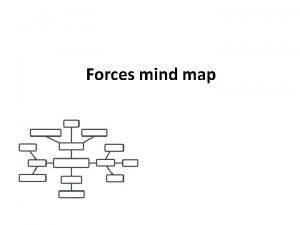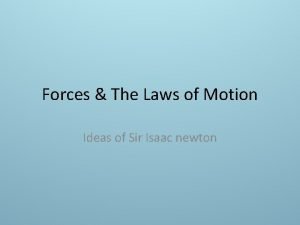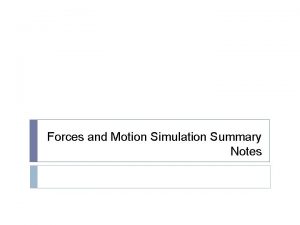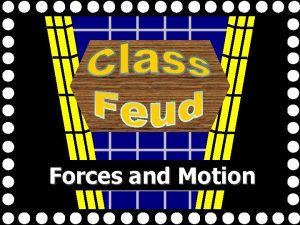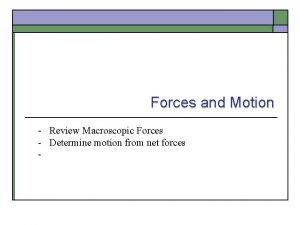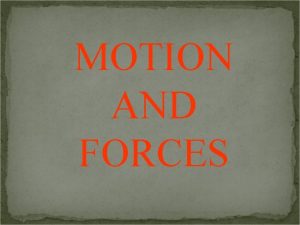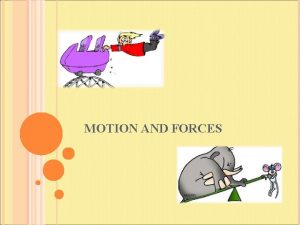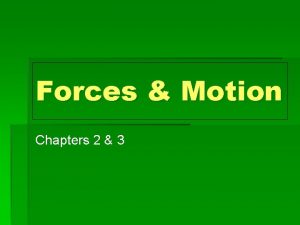Forces Pg 62 69 Analyzing Motion When analyzing












- Slides: 12

Forces Pg. 62 - 69

Analyzing Motion � When analyzing motion, the solution will typically require more than one step � Recall: Fnet = ma

Examples: 1. An object with a mass of 15 kg rests on a frictionless horizontal plane and is acted upon by a horizontal force of 30 N. What will be its velocity after 10 s? (20 m/s) 2. A car with a mass of 1000 kg is moving in a straight line at a constant speed of 30 m/s when the driver applies the brakes and brings the car to rest in 25 s. What constant force is acting to stop the car? (-2000 N[fwd])

Forces & Free-Body Diagrams (FBDs) � However, in almost every instance of motion, more than one force is acting on the object of interest. � To apply Newton’s second law, you need to find the resultant force (Fnet) � A FBD is a great tool to help ensure that you have correctly identified and combined the forces � Recall: Fnet = F 1+ F 2 + ….

Example 3. Two children are playing with a wagon. One child pulls forward on the rope tied to the front, while the other child pushes on the wagon from behind. Draw a FBD showing all of the forces acting on the wagon. Be sure to label the forces accordingly (hint: there are 5 forces in total)

Forces and FBD’s � Recall: � Examples of common forces that you encounter every day are Earth’s gravity, the normal force, tension, friction, applied forces, and air resistance � One type of friction, called static friction (Fs), is the force that tends to prevent a stationary object from starting to move � Once the object is moving, kinetic fiction (Fk), is the force that acts against an object’s motion in a direction opposite to the direction of motion � For horizontal motion, if the applied force has the same magnitude at the friction, the moving object will maintain uniform motion. In other words, if the object is at rest it will remain at rest and if it is in motion, it will remain in motion (constant velocity)

Example 4. A 0. 17 kg hockey puck slides along the ice at 19 m/s[E] when it hits a rough patch of ice that is 5. 1 m across. Assume the coefficient of kinetic friction (uk) between the puck and the rough ice is 0. 47 a) draw a FBD of the puck moving on the rough ice b) calculate the kinetic friction acting on the puck (0. 78 N[W] ` c) determine the puck’s average acceleration while on the rough ice (4. 6 m/s 2 [W]) d) calculate the puck’s velocity as it leaves the rough surface and returns to the smooth surface (vf = 18 m/s[E])

Forces and FBD’s � Determining the sum of all the forces acting on an object is straightforward if all of the forces are linear or perpendicular to each other, but the task is more complex if some of the forces are at angles other than 90 degrees. � In this case Fn = Fg but there are other instance where Fn ≠ Fg

Forces and FBD’s � One of these situations occurs when a force is applied an angle to the horizontal surface. � Note: In this case, a component of the applied force causes the crate to move horizontally

Forces and FBD’s � Another of these situations occurs when an object is sliding up or down an incline � Note: in order to analyze this motion, a different frame of reference is used and the force of gravity is resolved into its component forces

Example � 5. To move a 45 kg wooden crate across a wooden floor (u = 0. 20), a worker ties a rope onto the crate and pulls on the rope with a force of 115 N as shown. a) draw a FBD of the situation b) resolve Fa into its component forces and determine their values (Fay = 29. 8 N; Fax = 14. 5 N) c) how much time elapses before the crate is moving at 1. 4 m/s? (recall: L FBD -> Fnet -> a-> t) (2. 2 s)

Example 6. Classwork/homework: Pg. 69 #2, 4, 7, 9 Pg. 76 #3 Pg 83. #5 Two people pull on an object at different angles but with equal force. a) which person applied the greater horizontal force to the load? (hint: if no measurements are given in a problem you may want to assume some. In this case, assume a for of 100 N and angles of 30 degrees and 60 degrees respectively) (Fboy = 87 N, Fgirl = 50 N) b) what effect does this have on the horizontal motion of the load? (object moves toward the boy) c) which person applies the greater vertical force to the load? (Fboy = 50 N; Fgirl = 87 N) d) what effect does this have on frictional forces? On the vertical motion of the load? (reduces friction, Fn<Fg,
 Tools for measuring kinematic quantities
Tools for measuring kinematic quantities Intramolecular forces vs intermolecular forces
Intramolecular forces vs intermolecular forces The forces shown above are pushing/pulling forces
The forces shown above are pushing/pulling forces Contact force
Contact force Intermolecular forces from strongest to weakest
Intermolecular forces from strongest to weakest Net force
Net force Difference between intramolecular and intermolecular
Difference between intramolecular and intermolecular What is constructive forces
What is constructive forces Example of unlike parallel force
Example of unlike parallel force Mind map about friction
Mind map about friction Study jams force and motion
Study jams force and motion Forces and the laws of motion problem b
Forces and the laws of motion problem b What is balanced force
What is balanced force









